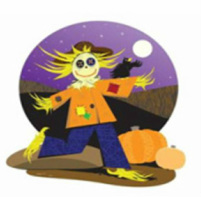
The History of Scarecrows
by Noah Ramm
Comparing Scarecrows in the United States and Ireland
In a way, scarecrows are the oldest companion to humans. Since early agricultural times, once farming societies began, scarecrows would help keep crows and other hungry mouths off crops. They also helped provide many imaginative ideas. Nowadays, people enjoy creating scarecrows to welcome in fall. They are a sign of Autumn pleasures such as apple picking, pumpkin carving, hayrides, and trick-or-treating. Scarecrows are still found all over the world, serving as decoration and protecting over corn fields.
For most people in the United States, scarecrows are made with old clothes, clothes people have grown out of, or clothes that have a sentimental meaning. For my scarecrow, I used ALL of those ideas. My scarecrow's shirt is a pair of my favorite old shorts. I used my old jeans for his jeans. Instead of the typical red handkerchief, I used a blue bandana that I got at STEM Camp this summer. For the hair, I used one of my mom's belts; I can remember playing with this belt as a very little kid. It was fun to create this scarecrow with so many memorable pieces!
Questions About Scarecrows
What did people use or do to guard the fields before the scarecrow was invented?
Many different places around the world had people guard their fields. Some, like the Pilgrims, called them "bird scarers".
Who invented the first scarecrow? When was it invented?
People have been using scarecrows for over 3000 years.
The first scarecrows in recorded history were made along the Nile River to protect wheat fields from flocks of quail.
What was the first scarecrow made out of?
Egyptian farmers put wooden frames in their fields and covered them with nets. The farmers hid in the fields and scared the quail into the nets. Then they took them home and ate them for dinner!
Information from:
https://www.reference.com/history/history-scarecrows-e4a0929ff85037ab
Scarecrows in the United States
The history of the scarecrow in the United States dates back to the Native Americans, who used scarecrows or bird scarers to help protect their crops. In the 1600s, early settlers in Plymouth Massachusetts took turns standing guard in their fields as "bird scarers". Later, instead of people, a wooden or straw figure would be used. By the 1800s, immigrants had many ideas for creating scarecrows.
German farmers made human-looking scarecrows dressed in overalls, long-sleeved shirts or coats, and woolen or straw hats. The large red handkerchief around the neck of the scarecrow seemed to be a traditional feature. They called these creations "bootzamon" or bogeyman. They would also make a female version called "bootzafrau" or bogeywife, that they dressed in a long dress or coat and a sunbonnet.
During the Great Depression, there were not many scarecrows seen. After World War II, farmers began using chemicals to protect their crops. After scientists discovered the harmful effects, farmers returned to using scarecrows, but much like "whirligigs that revolved like windmills to scare away the birds."
Information from
http://www.redlandsdailyfacts.com/lifestyle/20131007/history-of-the-scarecrow and
http://historybecauseitshere.weebly.com/scarecrows-historically-speaking.html
Scarecrows in Ireland
In Ireland scarecrows can be found in the Durrow Scarecrow Village and in the surrounding areas and village from late July until early August at an annual festival called the "All Ireland Scarecrow Festival".
The typical scarecrow in Ireland watches over muddy English fields. This scarecrow usually wears a yellow raincoat that covers overalls. Many times there's even a lady scarecrow wearing tinsel. Sometimes the Irish Scarecrow wears a green and black beret and others it's dressed in an overcoat, "britches", and a shirt and tie. There's lots of variety with the Irish Scarecrow!
The Scarecrow Journal
By Noah
It started off as an ordinary morning. There wasn't much happening. I was just standing in my corn field watching crows fly by. But then, there was a sudden gust of wind. All at once, my entire body flew into the air and just as suddenly plummeted to the ground. My body was all bent and broken; my arms were detached from my body and my legs were bent behind my body.
I felt just as broken on the inside as I looked on the outside. I tried to scream as hard as I could, but no sound came out. If felt as if I was hopeless, never to stand up again. I tried to get attention from the crows to help me get back up on my feet. But it was no use. All they did was fly around eating bits of corn, since I was not there to protect my field.
What felt like hours went by in a flash. Before I knew it, the farmer helped put me back together and get me back on my feet. He even gave me a nice new scarf!
I was even more surprised when the farmer put another scarecrow next to me. This scarecrow looked much different than I did. Instead of overalls, a long-sleeved shirt, and a straw hat, this scarecrow had a bonnet and a dress. SHE looked beautiful and happy.
I knew that having a companion would help me protect the fields and stay safe. Never again would I be alone.
SCARECROW
Email: JoeScarecrow@ParkSchools.org
Website: https://en.wikipedia.org/wiki/Scarecrow
Location: 1220 Cornfield Lane, Autumn Fall, RI
Facebook: facebook.com/NoahsScarecrowProject
Twitter: @twitter_JoeScarecrow









